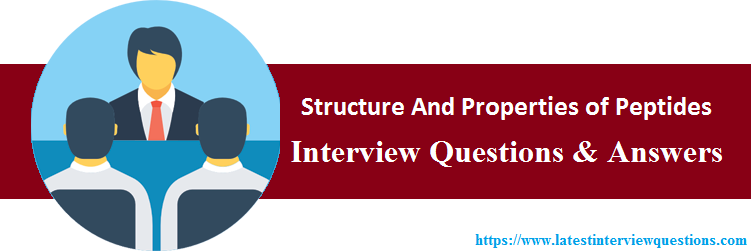Structure And Properties of Peptides Interview Questions & Answers
Posted On:May 22, 2019, Posted By:Latest Interview Questions,
Views:2045, Rating : 









Best Structure And Properties of Peptides Interview Questions and Answers
Dear Readers, Welcome to Structure And Properties of Peptides Objective Questions and Answers have been designed specially to get you acquainted with the nature of questions you may encounter during your Job interview for the subject of Structure And Properties of Peptides Multiple choice Questions. These Objective type Structure And Properties of Peptides Questions are very important for campus placement test and job interviews. As per my experience good interviewers hardly plan to ask any particular question during your Job interview and these model questions are asked in the online technical test and interview of many Medical Industry.
1. Disulfide bonds most often stabilize the native structure of
A. extracellular proteins
B. dimeric proteins
C. hydrophobic proteins
D. intracellular proteins
Answer: A

2. Secondary structure in protein refers to
A. linear sequence of amino acids joined together by peptide bond
B. three dimensional arrangement of all amino acids in polypeptide chain
C. regular folding of regions of the polypeptide chain
D. protein made up of more than one polypeptide chain
Answer: C
3. Heme is the binding pocket of myoglobin and hemoglobin and is composed of
A. negatively charged residues
B. polar residues
C. hydrophobic residues
D. positively charged residues
Answer: C
4. What is the effect of a decrease in pH on hemoglobin oxygen affinity?
A. Decrease in oxygen affinity
B. Increase in oxygen affinity
C. No effect on oxygen affinity
D. Increase affinity in muscle cell otherwise decrease
Answer: A
5. What is the proportion of glycine residues in collagenous regions?
A. One-fourth
B. One-third
C. Half
D. One-tenth
Answer: B
6. Which of the following statements is incorrect?
A. Protein G contains both a-helix and P-sheet
B. Protein G contains only a-helix
C. Fatty acid binding protein contains largely P-sheet
D. Hemoglobin contains four sub-units
Answer: B
7. The oxygen binding curves of hemoglobin and myoglobin
A. allow maximum transfer of oxygen to the tissues
B. are a consequence of the quaternary structure of hemoglobin
C. both (a) and (b)
D. are identical
Answer: C
8. The nature of peptide bond can be best explained as
A. partial double bond
B. truly double bond
C. Hydrogen bond
D. Van der waals force
Answer: A
9. Which of the following statement is incorrect?
A. Hemoglobin and myoglobin are the two oxygen binding proteins
B. Hemoglobin transports O2 in the blood
C. Myoglobin stores O2 in muscles
D. None of the above
Answer: D
10. Which hemoglobin chain replaces the beta chain in embryonic hemoglobulin?
A. Delta
B. Epsilon
C. Gamma
D. Alfa
Answer: B
11. Hemoglobin has quaternary structure and is made up of
A. six polypeptide chains, two a-chains and four ß-chains
B. two polypeptide chains, one a-chains and one ß-chains
C. four polypeptide chains, two a-chains and two ß-chains
D. five polypeptide chains, two a-chains and three ß-chains
Answer: C
12. When pO2 = Kd of myoglobin, the fractional saturation (YO2) is about
A. 0.1
B. 0.5
C. 0.9
D. 1.7
Answer: B
13. Peptides in the fully extended chain conformation
A. have Y = F = 180°
B. do not occur in nature
C. also have a cis geometry in their peptide bonds
D. are equivalent to the (3-sheet structure)
Answer: A
14. The oxygen in hemoglobin and myoglobin is bound to
A. the iron atom in the heme group
B. the nitrogen atoms on the heme
C. histidine residues in the protein
D. lysine residues in the protein
Answer: A
15. Which of the three subunits of the G proteins binds GDP and GTP?
A. Alpha
B. Beta
C. Gamma
D. Delta
Answer: A